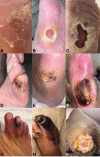Etiology, Epidemiology, and Disparities in the Burden of Diabetic Foot Ulcers
- PMID: 36548709
- PMCID: PMC9797649
- DOI: 10.2337/dci22-0043
Etiology, Epidemiology, and Disparities in the Burden of Diabetic Foot Ulcers
Abstract
Diabetic foot ulcers (DFU) are a major source of preventable morbidity in adults with diabetes. Consequences of foot ulcers include decline in functional status, infection, hospitalization, lower-extremity amputation, and death. The lifetime risk of foot ulcer is 19% to 34%, and this number is rising with increased longevity and medical complexity of people with diabetes. Morbidity following incident ulceration is high, with recurrence rates of 65% at 3-5 years, lifetime lower-extremity amputation incidence of 20%, and 5-year mortality of 50-70%. New data suggest overall amputation incidence has increased by as much as 50% in some regions over the past several years after a long period of decline, especially in young and racial and ethnic minority populations. DFU are a common and highly morbid complication of diabetes. The pathway to ulceration, involving loss of sensation, ischemia, and minor trauma, is well established. Amputation and mortality after DFU represent late-stage complications and are strongly linked to poor diabetes management. Current efforts to improve care of patients with DFU have not resulted in consistently lower amputation rates, with evidence of widening disparities and implications for equity in diabetes care. Prevention and early detection of DFU through guideline-directed multidisciplinary care is critical to decrease the morbidity and disparities associated with DFU. This review describes the epidemiology, presentation, and sequelae of DFU, summarizes current evidence-based recommendations for screening and prevention, and highlights disparities in care and outcomes.
© 2022 by the American Diabetes Association.
Conflict of interest statement
Figures





References
-
- International Diabetes Federation . The Diabetic Foot. Brussels, Belgium, International Diabetes Federation, 2020. Accessed 1 August 2022. Available from https://www.idf.org/our-activities/care-prevention/diabetic-foot.html
-
- Armstrong DG, Boulton AJM, Bus SA. Diabetic foot ulcers and their recurrence. N Engl J Med 2017;376:2367–2375 - PubMed
-
- Hoffstad O, Mitra N, Walsh J, Margolis DJ. Diabetes, lower-extremity amputation, and death. Diabetes Care 2015;38:1852–1857 - PubMed
-
- van Netten JJ, Bus SA, Apelqvist J, et al.; International Working Group on the Diabetic Foot . Definitions and criteria for diabetic foot disease. Diabetes Metab Res Rev 2020;36(Suppl. 1):e3268. - PubMed
Publication types
MeSH terms
Grants and funding
LinkOut - more resources
Full Text Sources
Medical
Miscellaneous

